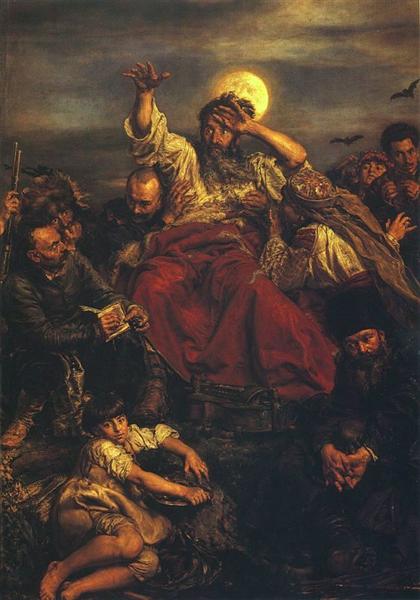Description
The work "Wernyhora" by Jan Matejko, painted in 1884, is an emblematic example of the artist's style, which is often characterized by the rich historical imagery, drama and almost photographic thoroughness in the representation of scenes of Polish history. In this painting, Matejko focuses on a central character, the mythical Ukrainian bard Wernyhora, who is presented in an evocative environment that suggests both his cultural role and his tragic narrative.
On the canvas, Wernyhora is portrayed at a time of great introspection and solemnity. The use of color is particularly significant; The bottoms out of the background contrast with the rich and colorful clothing of the protagonist. Matejko's palette covers various contrasts, from the brown and terrible green of the landscape to the red and golden vibrant of the attire, which generates a strong visual tension and highlights the figure of the bard in the middle of an atmosphere of nostalgia and destination.
The composition is remarkable for its asymmetry; Wernyhora occupies the lateral part of the painting, which suggests a movement towards the future or towards an unknown direction, and at the same time can evoke its connection with the past and the history of its people. Bardo's reflective look suggests a deep understanding of the vicissitudes of destiny, and its position indicates a threshold between what has been and what could be. The use of symbolic elements, such as the presence of a group of characters in the background, adds layers of meaning; These figures can be interpreted as the shadows of their history or the echoes of the tradition that Wernyhora represents.
Matejko stands out in his ability to raise historical and folk issues, and "Wernyhora" is no exception. The bard is at the intersection of poetry and history, symbolizing the rich cultural heritage of Poland and Ukraine. His rich and elaborate clothing, along with his dominant position in the painting, They evoke respect and admiration that bards have had throughout history as bearers of oral tradition and collective memory.
As in many of Matejko's works, detail attention is impressive. Each fold of clothes, each expression of the characters, and every element of the landscape is executed with a meticulous dedication to historical veracity and emotional depth. In "Wernyhora", this detailed approach not only serves to tell a visually attractive story, but also to invoke a sense of national identity, something that Matejko often seeks in his work.
Matejko's style, which incorporates elements of realism and romanticism, also manifests itself in the grandiosity of the work. The representation of characters often loaded with cultural symbolism aligns with the author's interest in highlighting significant moments in Polish history. Although "Wernyhora" may seem less known compared to other works of its vast production, it represents an essential link in its exploration of identity, history and culture issues.
In conclusion, "Wernyhora" is more than a simple representation of a legendary character; It is a visual statement that captures the richness and complexity of cultural tradition. With each stroke and every color, Jan Matejko not only evokes the figure of the bard, but also celebrates the nation that represents, in a work that continues to resonate in the heart of the Polish heritage.
KUADROS ©, a famous paint on your wall.
Hand-made oil painting reproductions, with the quality of professional artists and the distinctive seal of KUADROS ©.
Art reproduction service with satisfaction guarantee. If you are not completely satisfied with the replica of your painting, we refund your money 100%.

